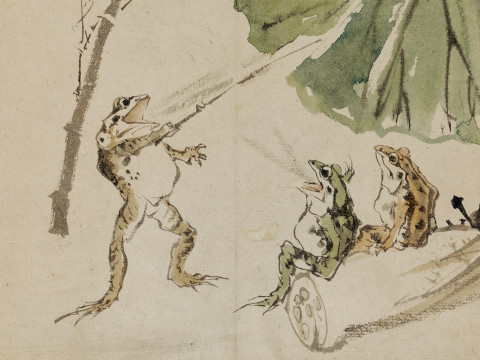
How to read it: Edward Burne-Jones's The Summer Snow
By Amanda-Jane Doran
Published on 7 December 2017
Edward Burne-Jones and his fellow Pre-Raphaelites are famed for their paintings, but their illustrations, which were an important part of their early careers, are less well-known. Here’s a closer look at one of Burne-Jones's wood engravings.

Who is this woman?
This striking image is a portrait of Jane Morris in the early years of her marriage to the artist’s close friend and artistic collaborator, William Morris. She is identified by her dramatic, barely tamed, wavy hair and idiosyncratic, medieval-style dress, which she designed and made herself. Jane Morris was probably the most iconic Pre-Raphaelite model – her swan-neck pose is typical of the many later paintings of her by fellow Pre-Raphaelite, Dante Gabriel Rossetti, who was one of Burne-Jones’s inspirations. The framing device of stylised trees and leaves points to the groundbreaking design work developed and pioneered by William Morris’ company Morris & Co. Jane Morris and her daughters were pioneering craftswomen, producing and designing art needlework for Morris & Co.
How was it made?
This is a wood engraving, made from Burne-Jones’s design. Wood engravings were well-suited to mass production as they produced clear black-and-white images. Burne-Jones made the drawing directly onto a box wood block. It was then passed to a team of engravers; in this case the Dalziel Brothers, who ran a commercial wood-engraving studio and were regarded as the most skillful engravers in London during the 1860s. Occasionally individual master engravers were employed in this work; many women also trained as wood engravers in the 19th century including Georgiana, Burne-Jones’s wife. It is just possible that she might have had a hand in this engraving. Artists and engravers corresponded closely over the finished engravings, in order for the effect of the original drawing to be followed as closely as possible.

Where was it published?
This illustration by Edward Burne-Jones was made to embellish a poem entitled Summer Snow, printed in Good Words magazine in May 1863. Good Words was a monthly religious magazine edited by Queen Victoria’s chaplain, Dr Norman McLeod. The magazine was very popular and published novels in parts, travel journalism and edifying poetry. Burne-Jones made two illustrations for the magazine in 1862 and 1863, when he was working in close collaboration with William Morris and Rossetti.
Who’s the illustrator?
Sir Edward Burne-Jones ARA is primarily known for his luminous and languorous paintings of mythical beauties, framed by swirling emblematic flowers and foliage. At the beginning of his artistic career he was hugely inspired and influenced by the wood engraved illustrations of German history painter, Alfred Rethel. Rethel took Dürer and Holbein as his models in medieval style and macabre content. Dante Gabriel Rossetti’s book illustration, The Maids of Elfen-Mere, published in 1855, provided a turning point in Burne-Jones’s life. He sought out the artist and became a fixture in Rossetti’s studio and social circle, making him the earliest follower of the founders of the Pre-Raphaelite Brotherhood: Rossetti, John Everett Millais and William Holman Hunt.
The Summer Snow can be seen alongside illustrations by a number of Pre-Raphaelite artists in the display Works of Feeling: Pre-Raphaelite Book Illustration in the Royal Academy Print Room until 20 December 2017.
Related articles

The meteoric rise of Angelica Kauffman RA
2 January 2024

Untold Stories
26 October 2023

RA Collections Decolonial Research Project
28 March 2022

Late Constable Tour with Curator Anne Lyles
6 December 2021

